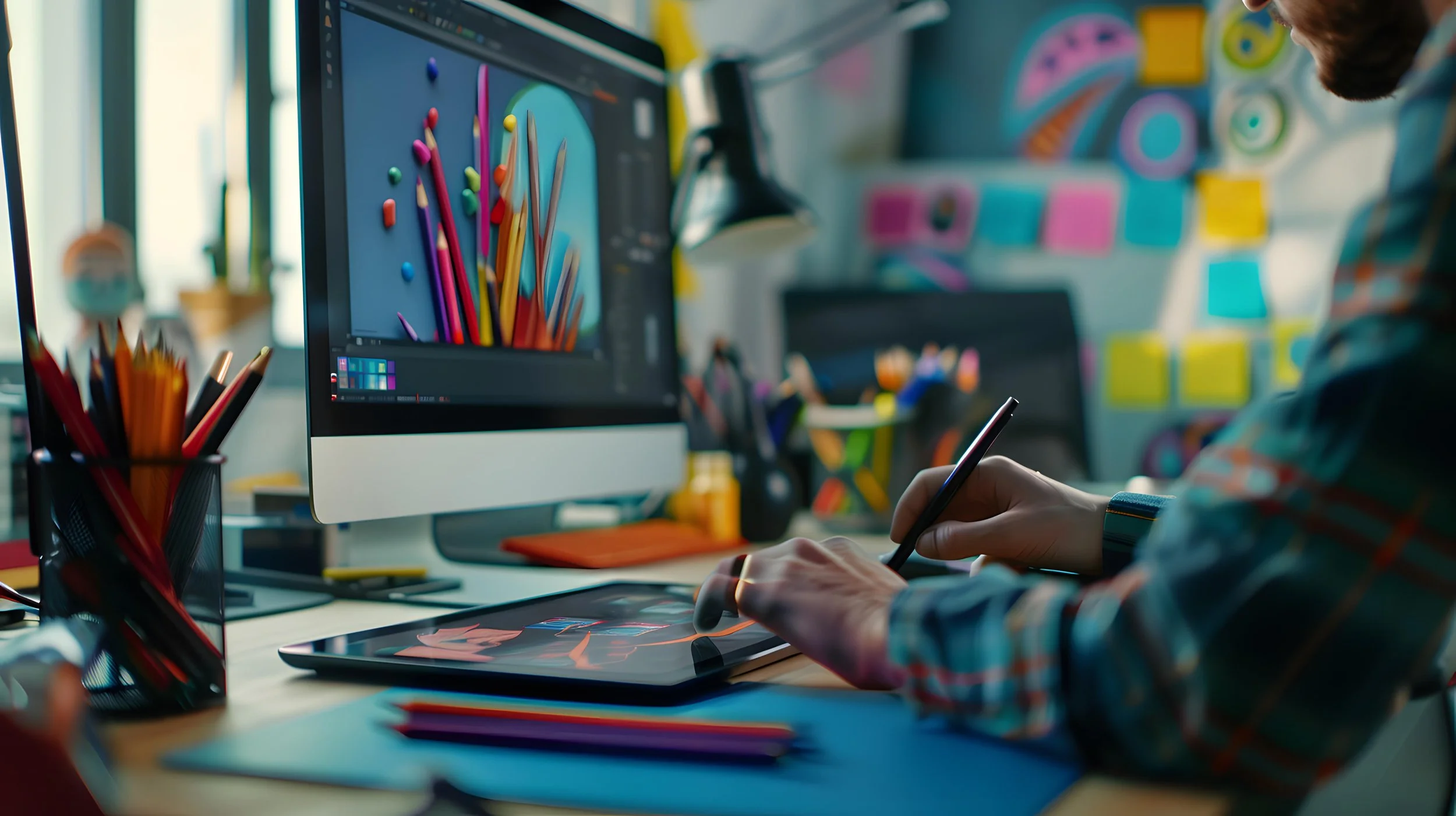Developing a Consistent Design Aesthetic: The Key to Cohesive Branding
Written by Anthony Austin
Credit: Freepik
In today's visual-driven world, having a consistent design aesthetic is more than just a preference—it’s essential. Whether you're a brand, content creator, entrepreneur, or designer, maintaining a unified look across your visual content strengthens your identity, improves recognition, and builds trust with your audience. But how do you develop and maintain a consistent design aesthetic that aligns with your goals and resonates with your audience?
In this blog, we’ll explore why consistency is important, how to build a solid design foundation and offer actionable tips for developing and maintaining a design aesthetic that stands the test of time.
Why Consistency in Design Matters
A consistent design aesthetic is about more than just making things look pretty—it’s about storytelling. Every visual element contributes to how people perceive your brand, message, or personal identity. When these elements are cohesive, they create a stronger connection with the audience. Here’s why consistency is so crucial:
Builds Brand Recognition: A consistent aesthetic makes your brand recognizable across different platforms and mediums. Think about iconic brands like Apple or Nike—whether it’s their website, social media, or packaging, you immediately recognize their aesthetic.
Establishes Trust: Consistency signals professionalism. When your design is cohesive, it suggests that you pay attention to details, which builds trust with your audience. They’ll feel more confident in your products, services, or content because you’ve taken the time to refine your presentation.
Enhances User Experience: A consistent design aesthetic creates a seamless experience for your users. Whether they’re browsing your website, looking at your social media, or receiving your emails, the cohesive visuals guide them through the content without confusion.
Strengthens Emotional Connection: Visuals evoke emotion. When your design aesthetic consistently aligns with your brand’s message, values, and tone, it resonates more deeply with your audience. Over time, this consistency helps foster loyalty and emotional attachment.
Step 1: Understand Your Brand or Personal Identity
Before diving into design elements, you need to have a clear understanding of your brand or personal identity. This includes your core values, mission, tone, and the message you want to convey. Ask yourself the following:
What is your story? What do you want your audience to know about you or your brand?
Who is your audience? Understanding their preferences, values, and habits will guide your aesthetic choices.
What emotions or qualities do you want to evoke? Are you aiming for fun and playful or sleek and professional? Warm and inviting or bold and cutting-edge?
Defining these key points will set the foundation for every design decision moving forward.
Step 2: Choose a Visual Style That Represents You
Once you’ve defined your brand or personal identity, the next step is to translate that into a visual style. This involves selecting key design elements that reflect your brand's values and connect with your target audience. Key areas to focus on include:
1. Color Palette
Your color palette is one of the most defining aspects of your design aesthetic. The colors you choose will evoke certain emotions and set the tone for your visuals.
Neutral palettes (e.g., whites, greys, and earth tones) often evoke professionalism, simplicity, or a clean aesthetic.
Bold, bright palettes tend to be more playful, youthful, and energetic.
Monochromatic palettes can create a sleek, minimalist look, while complementary color schemes can add depth and visual interest.
When choosing your color palette:
Stick to a base of 3-5 colors.
Consider the psychology of color and what feelings you want to evoke (e.g., blue for trust, red for passion, green for health).
Use color consistently across all materials (e.g., website, social media, print).
2. Typography
Typography is a subtle yet powerful tool in defining your design aesthetic. The fonts you use can convey authority, creativity, or even whimsy. Selecting a consistent set of typefaces for your brand ensures readability and helps create a cohesive look.
Serif fonts (fonts with little "feet" at the ends of letters) convey tradition, authority, and formality (e.g., Times New Roman, Garamond).
Sans-serif fonts (fonts without the "feet") are modern, clean, and more informal (e.g., Helvetica, Arial).
Script or hand-drawn fonts add a personal, creative, or elegant touch, but should be used sparingly to avoid sacrificing readability.
Consistency in typography is key:
Choose one to two primary fonts (one for headings and one for body text) and stick to them across all mediums.
Avoid using too many fonts, as this can create a chaotic and inconsistent look.
3. Imagery and Graphics
Imagery plays a crucial role in your design aesthetic, whether it’s photography, illustrations, or iconography. The types of images you choose should align with your brand identity and be consistent in style, tone, and quality.
Photography: If you use photography, decide whether it will be light and airy, moody and dark, or vibrant and bold. Stick to a specific style of imagery that aligns with your overall message.
Illustrations: If you prefer illustrations, maintain a consistent look. For example, if you use minimalist, flat illustrations, avoid mixing them with highly detailed or 3D-rendered images.
Icons: When using icons, stick to a consistent style, such as all outline icons or all filled icons.
Consistency in imagery will reinforce your visual identity and create a more unified look across all your platforms.
Step 3: Develop Brand Guidelines (Your Style Guide)
Once you've defined the key elements of your aesthetic, it’s essential to develop brand guidelines. These guidelines will serve as a reference for you (and any collaborators) to ensure that every piece of visual content aligns with your design aesthetic. Here’s what to include in your style guide:
Logo Usage: Specify how your logo should be used, including acceptable sizes, color variations, and spacing.
Color Palette: Document your primary and secondary colors, along with their hex codes or CMYK values to ensure accurate reproduction across all mediums.
Typography: List your chosen fonts, their sizes, and how they should be used in different contexts (e.g., headers, body text, quotes).
Imagery Guidelines: Define the style, tone, and usage of photography, illustrations, and other imagery.
Tone of Voice: While this may not be directly related to design, your brand’s tone of voice should be consistent with your visual aesthetic. For example, a playful visual style should be complemented by a lighthearted tone.
Having these guidelines in place ensures that as your brand grows or as new content is created, the visual identity remains consistent and recognizable.
Credit: Midjourney 6
Step 4: Maintain Consistency Across All Platforms
It’s one thing to develop a cohesive aesthetic, but maintaining it across all platforms is key to solidifying your brand's identity. Ensure that your design elements are consistently applied to:
Website: Your website should be the flagship for your design aesthetic. Make sure your color palette, fonts, and imagery are consistent throughout.
Social Media: Each platform has its nuances, but your core design elements should be visible across all your social media channels. Whether it's Instagram, Facebook, or LinkedIn, consistent colors, fonts, and imagery will create a cohesive look.
Email Newsletters: Your email templates should align with your design aesthetic to ensure brand recognition every time your audience opens a message.
Print Materials: If you use business cards, brochures, or other printed materials, ensure that your digital and physical representations of your brand match.
Remember, the more touchpoints you have with your audience, the more important it becomes to have a unified visual identity.
Step 5: Evolve Your Design Aesthetic Over Time
While consistency is critical, it’s also important to remember that design trends and audience preferences change over time. A strong brand aesthetic isn’t static; it can evolve while maintaining core elements. As your business grows, technology advances, or your audience shifts, you may need to update your visual identity to stay relevant.
However, any changes should be intentional and gradual, maintaining enough consistency that your audience still recognizes your brand. Evolving your aesthetic may involve:
Refreshing your color palette with updated hues.
Refining your typography choices for modern appeal.
Updating your imagery style to reflect current trends or new brand values.
The key is to strike a balance between staying consistent and evolving with intention. When done correctly, this will keep your brand feeling fresh while retaining its core identity.
Developing a consistent design aesthetic is essential for any brand, business, or individual looking to make a lasting impact. By defining your identity, choosing visual elements that align with your message, and maintaining consistency across all platforms, you can build a recognizable and trustworthy presence.
Remember, your design aesthetic is more than just a collection of visual elements—it’s a reflection of your brand’s personality, values, and goals. Take the time to thoughtfully develop it, and you’ll create a lasting impression that resonates with your audience for years to come.
For more design content, check out some of our latest posts here.


